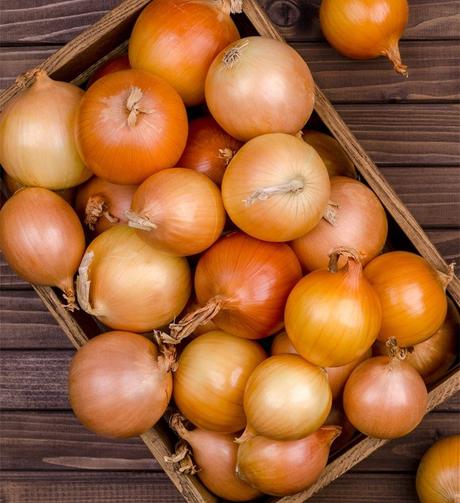
Spanish onions are a type of yellow onion and are sometimes mislabeled as brown onions. They have a thin, papery skin, and pale yellow flesh and are moderately pungent compared to other onion varieties when raw. Once cooked, however, Spanish onions turn sweet and tender. Given their subtle flavor, Spanish onions are great to use in sandwiches and salads as well as in soups, sofrito, and some grilled dishes.
Spanish onions are a versatile, multi-purpose ingredient, but they can be expensive and hard to find. So, if you can't find them, you can use these Spanish onion substitutes instead to get similar results in your dish.
1. Red Onions
Red onions ' flavor profile ranges from mild to pungent. It has dense flesh and a robust taste and pungent aroma that stands in stark contrast to the sweetness and mildness of Spanish onions. While there are differences in flavor profiles, red onions can be used to substitute Spanish onions, especially in dishes that will benefit from a stronger onion flavor.
You can use raw red onions in salads or pickle them. They also taste great when grilled. However, raw red onions will add a different color to the dish - although this change in color will only elevate your recipe's aesthetic appeal and not detract from it. When cooked, red onions look duller, which is perfect for heat-based dishes.
2. Sweet Onions
Sweet onions have a delicate flavor that is equal parts sweet and savory with plump, juicy flesh. They're irresistible in soups, salads, and sauces and can also be grilled and roasted. They have a sweet taste similar to Spanish onions and are also less likely to produce tears, making them an appealing alternative to the original ingredient.
You can use sweet onions in a variety of dishes and preparations, including toppings for pizzas and burgers, and in pies. Because they tend to be much milder in flavor with a sweet taste, you will need to add a little salt to balance out the flavors. They're generally crispy but break down easily when cooked and develop a softer texture, so they're not good for slow-cooked dishes.
3. Vidalia Onions
Vidalia onions are a type of sweet onion with a yellow or light brown hue and a thin, delicate skin. They have a mild flavor but a sweet taste and an aroma that's much like that of Spanish onions, making them the perfect alternative to use in dishes like salads.
You can use Vidalia onions to substitute for Spanish onions in any recipe without worrying about adding an overpowering onion flavor to the dish. Because it has such a mild and agreeable flavor, you can also consume Vidalia onions raw or add them to cold dishes. It's a multi-purpose ingredient that you can easily find in most stores.
4. Walla Walla Onions
Walla Walla onions get their name from the Walla Walla valley in Washington, the region where they're grown. They're large and round, have light golden skin with sweet and mellow-flavored flesh, and they also have higher water content than Spanish onions. Walla walla onions share a lot of similarities with Spanish onions and are thus a great substitute for the original ingredient.
Walla Walla onions tend to become even sweeter when cooked, making them a great choice for caramelized and roast dishes as well as sauces and dips. Given the subtle flavor profile, they are also good additions to rice and casseroles. However, Walla Walla onions are available from August through October, but you can cure them in a cool, dry, dark place to enjoy them for longer.
5. White Onions
White onions come in two types - American and European. American onions are sharper in flavor than their European counterparts. Apart from this distinction, both of these white onion variants have white, papery skin, a clean flavor, and crispy white flesh. They also offer a plethora of health benefits and can be used to replace Spanish onions in a pinch.
The sharp, pungent flavor of white onions with mild sweetness is perfect in warm dishes as well as sauteed preparations. They will also work in raw applications where the onions will maintain the integrity of the dish. They're a versatile option that makes for a simple substitute for Spanish onions in any cuisine. But, make sure you don't pre-cut them, as white onions will go bad when exposed to moisture-dense air.
6. Yellow Onions
Yellow onions are one of the most common types of onions. They have a strong flavor compared to Spanish onions, have a papery skin, and come in white to brown hues. These sharp-tasting onions work well in several recipes and make for a great substitute for Spanish onions, especially because it's closely related to the original ingredient.
You can use yellow onions in just about every recipe that calls for Spanish onions, including soups, stews, sauces, grilled meats, and roasted veggies. They become sweeter when cooked, and the reduced pungency also makes them suitable for caramelizing. Bear in mind that yellow onions have very little water content, so they won't work half as well for raw applications.
7. Ramps
Don't have access to any type of onion? Use ramps (leeks) to save the day. Ramps, also known as wild leeks and wood leeks, are a type of wild-growing onion. They're generally regarded to be cousins of onions and have a taste that lies somewhere between garlic and scallions. While not an exact alternative to Spanish onion, you can still use ramps to add a subtle onion taste to dishes.
You can eat ramps raw or use them to make pesto. You can also cook them like scallions, but you should know that ramps tend to turn slightly sweet when cooked. They work well in a range of applications, so feel free to explore the many possibilities to find your perfect recipe.
